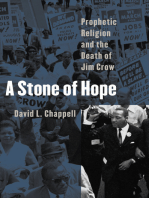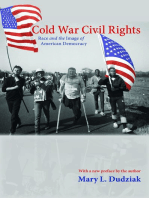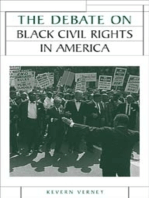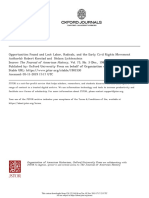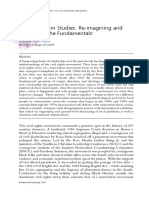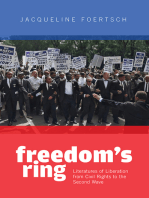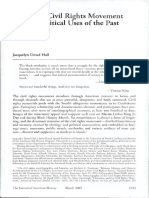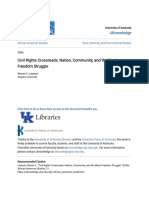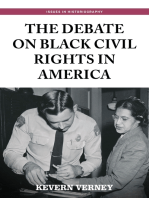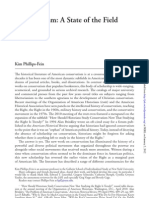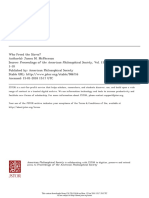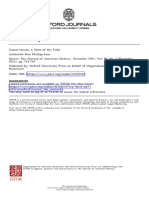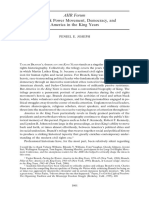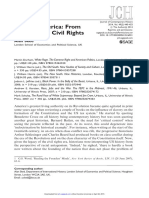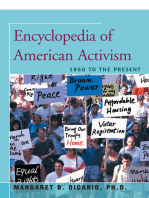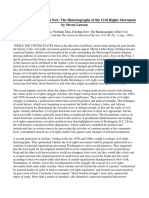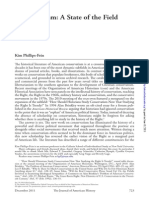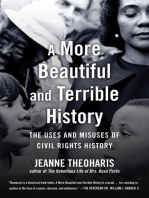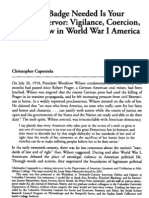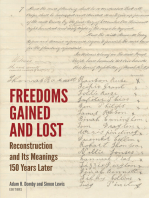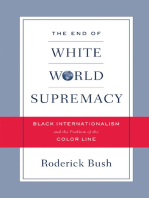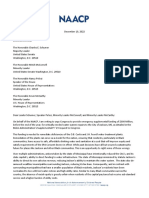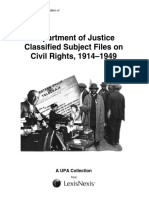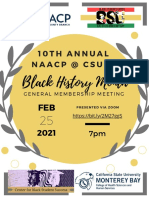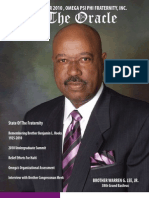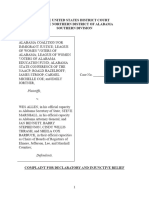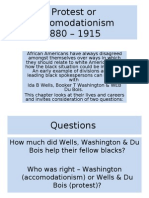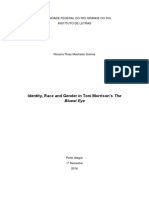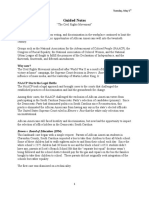Civil Rights Movement
Civil Rights Movement
Uploaded by
Iffat ZameerCopyright:
Available Formats
Civil Rights Movement
Civil Rights Movement
Uploaded by
Iffat ZameerCopyright
Available Formats
Share this document
Did you find this document useful?
Is this content inappropriate?
Copyright:
Available Formats
Civil Rights Movement
Civil Rights Movement
Uploaded by
Iffat ZameerCopyright:
Available Formats
Historians and the Civil Rights Movement
Author(s): Adam Fairclough
Source: Journal of American Studies , Dec., 1990, Vol. 24, No. 3 (Dec., 1990), pp. 387-398
Published by: Cambridge University Press on behalf of the British Association for
American Studies
Stable URL: https://www.jstor.org/stable/27555365
JSTOR is a not-for-profit service that helps scholars, researchers, and students discover, use, and build upon a wide
range of content in a trusted digital archive. We use information technology and tools to increase productivity and
facilitate new forms of scholarship. For more information about JSTOR, please contact support@jstor.org.
Your use of the JSTOR archive indicates your acceptance of the Terms & Conditions of Use, available at
https://about.jstor.org/terms
Cambridge University Press and British Association for American Studies are collaborating
with JSTOR to digitize, preserve and extend access to Journal of American Studies
This content downloaded from
149.10.125.20 on Fri, 18 Mar 2022 03:40:09 UTC
All use subject to https://about.jstor.org/terms
State of the Art
Historians and the Civil Rights Movement
ADAM FAIRCLOUGH
What was the civil rights movement? When did it begin and end, and what did
it achieve? As time distances historians from the events they study, periods that
once appeared sharply defined become fuzzy at the edges, and changes that
contemporaries thought sudden and profound seem less impressive than
underlying continuities.
The popular "Montgomery to Memphis" time-frame brackets the movement
with the leadership of Martin Luther King, Jr., 1955-68. In their search for
origins, however, historians have traced the civil rights movement beyond
Montgomery, beyond Brown v. Board of Education, and beyond even World War
II. It was during the Great Depression, Harvard Sitkoff argues, that " the seeds
that would later bear fruit" were planted; by 1940 blacks believed "that a new
page in American history had been turned. " According to Robert Norrell, the
late 1930s and 1940s revealed "not just a few tantalizing moments of protest, but
a widespread, if not yet mature, struggle to overthrow segregation and
institutionalized racism. " Robert Korstad and Nelson Lichtenstein place the
beginning of the civil rights era in the labor radicalism of the early 1940s, "when
the social structure of black America took on an increasingly urban, proletarian
character," and half a million black workers joined CIO unions. During the
1940s, moreover, the NAACP increased its membership from 50,000 to 450,000,
growth that occurred mostly in the South. These years also saw blacks agitating
for the ballot, founding political organizations, and, in the wake of Smith v.
Allwright (1944) - a landmark decision ably documented by Darlene Clark Hine
- becoming registered voters in significant numbers.1
Adam Fairclough is Senior Lecturer in History, St. David's University College, University
of Wales, Lampeter, Dyfed, SA48 7ED.
1 Harvard Sitkoff, A New Deal for Blacks : The Emergence of Civil Rights as a National Issue
(New York: Oxford University Press, 1978), 335; Robert J. Norrell, Reaping the
Whirlwind: The Civil Rights Movement in Tuskegee (New York: Alfred A. Knopf, 1985),
x; Robert Korstad and Nelson Lichtenstein, "Opportunities Lost and Found: Labor,
Radicals, and the Early Civil Rights Movement, " Journal of American History, 75
(December 1988), 786?811 ; Darlene Clark Hine, Black Victory: The Rise and Fall of the
White Primary in Texas (Millwood, NY: K.T.O. Press, 1979).
Journal of American Studies, 24 (1990), 3, 387-398 Printed in Great Britain
This content downloaded from
149.10.125.20 on Fri, 18 Mar 2022 03:40:09 UTC
All use subject to https://about.jstor.org/terms
388 Adam F air dough
It is tempting, therefore, to link the struggles of the 1940s to those of 195 5-65,
downgrading the conventional "turning-points" - Brown, Montgomery, and the
student sit-ins - to mere sub-divisions of a larger whole. Raphael Cassimere, Jr.,
an historian and NAACP activist, has even suggested that the civil rights
movement began "at least as early as the end of the nineteenth century," in
protest against Plessy v. Ferguson. Looking at the other end of the period,
Clay borne Carson has challenged the notion that "The civil rights movement
died during the mid-1960s" to be displaced by a Black Power movement with
dissimilar goals. In reality, argues Carson, local activists made no such distinction :
the earlier movement to attain political rights evolved into a movement to
exercise those rights; both comprised a larger "black freedom struggle seeking
a broad range of goals. " The trouble with such broad definitions, however, is
that in stressing history's "seamless web" they turn history into a homogenized
mush, without sharp breaks and transformations. "The people who were
involved in the movement in the 1950s and 1960s called it the civil rights
movement," insists Hugh Murray. "Historians in pipe-smoke filled rooms ought
not to try to rename it." In retaining the notion of a distinct civil rights
movement, however, we need to ask: What made it a discrete "movement"?
And what was its relationship to earlier and subsequent struggles?2
In explaining the emergence of the civil rights movement, the historical
context is crucial. There is now a wealth of literature examining the late 1930s and
1940s. The NAACP's legal offensive against separate and inferior education,
which began in 1935 and culminated in the 1954 Brown decision, has been
explored in Richard Kluger's detailed study of the Brown cases, Genna Rae
McNeil's fine biography of Charles H. Houston, and Mark V. Tushnet's
trenchant analysis of the NAACP's legal strategy.3 Thanks to the work of Ralph
Dalfiume, Lee Finkle, Neil A. Wynn, Harvard Sitkoff and others, the wartime
years are no longer the "forgotten years" of the black struggle.4 William C.
2 Raphael Cassimere, Jr., "Equalizing Teachers' Pay in Louisiana," Integrated Education
(July-August 1977), 3?8; Clayborne Carson, "Civil Rights Reform and the Black
Freedom Struggle, " in Charles W. Eagles (ed.), The Civil Rights Movement in America
(Jackson: University of Mississippi Press, 1986), 19?37; Hugh Murray, "Change in the
South," review essay, Journal of Ethnic Studies, 16 (Summer 1988), 119-35.
3 Genna Rae McNeil, Groundwork : Charles Hamilton Houston and the Struggle for Civil Rights
(Philadelphia: University of Pennsylvania Press, 1983); Richard Kluger, Simple Justice :
The History of Brown v. Board of Education and Black America's Struggle for Equality (New
York: Alfred A.Knopf, 1976); Mark V. Tushnet, The NAACP's Legal Strategy
Against Segregated Education, 192J?19J0 (Chapel Hill: University of North Carolina Press,
1987).
4 Richard M. Dalfiume, "The 'Forgotten Years' of the Negro Revolution," Journal of
American History, 55 (June 1968), 90-106, and Desegregation of the U.S. Armed Forces:
Fighting on Two Fronts, 1939-19 j? (Columbia: University of Missouri Press, 1969); Lee
Finkle, Forum for Protest : The Black Press During World War II (Cranbury, NJ :
Associated University Press, 1975); Neil A. Wynn, The Afro-American and the Second
World War (London: Paul Elek, 1976); Harvard SitkofF, "Racial Militancy and
Interracial Violence in the Second World War," Journal of American History, 58
(December 1971), 661-81.
This content downloaded from
149.10.125.20 on Fri, 18 Mar 2022 03:40:09 UTC
All use subject to https://about.jstor.org/terms
Civil Rights Movement 389
Berman, Donald R. McCoy and Richard T. Ruetten have analyzed the emergence
of black civil rights as a national political issue during the late 1940s.5 A number
of studies explore the challenge to white supremacy from southern liberals and
radicals, as well as the more defensive, conservative positions of southern
"moderates."6
How then did the political currents of the Roosevelt-Truman years relate to the
civil rights movement? Dalfiume, McCoy, and Ruetten view World War II and
the early Truman years as a crucial period of black progress that underpinned all
subsequent advances. 1940 ushered in "a new age of race relations" because the
war years decisively loosened the grip of white racism. But Sitkoff, Finkle,
Burran, and Zangrando see no great breakthrough: blacks did not turn to
A. Philip Randolph's program of mass nonviolent direct action ; concessions like
the Fair Employment Practices Commission proved meaningless; white
supremacy and segregation remained intact; and the South retained sufficient
political clout to kill FEPC, frustrate the NAACP's efforts to pass an anti
lynching bill, and wreck Truman's civil rights program. Wynn takes an
intermediate position : blacks made clear gains during the war, but failure to build
on that progress created a mood of frustration that eventually led to more militant
tactics.7
Whatever the magnitude of black gains during the 1940s, it is clear that the
Cold War ended one phase of the struggle. The politics of the Roosevelt era
petered out in the late 1940s as anticommunist hysteria extinguished the Old Left,
put liberals on the defensive, and strengthened the forces of conservatism. Yet
historians of the civil rights movement have generally glossed over the impact of
the Cold War. According to Manning Marable, Hugh Murray and Gerald Home,
McCarthyism suppressed a nascent civil rights movement by destroying
organizations like the Southern Conference for Human Welfare, the Southern
Negro Youth Congress, the Progressive Party, and the Civil Rights Congress.
5 William C. Berman, The Politics of Civil Rights in the Truman Administration (Columbus :
Ohio State University Press, 1970); Donald R. McCoy and Richard T. Ruetten, Quest
and Response : Minority Rights and the Truman Administration (Lawrence : University of
Kansas Press, 1973).
6 Thomas A. Krueger, And Promises to Keep : A History of the Southern Conference for Human
Welfare (Nashville: Vanderbilt University Press, 1967); Anthony P. Dunbar, Against
the Grain: Southern Radicals and Prophets, 1929-19J9 (Charlottesville: University of
Virginia, 1981) ; Morton Sosna, In Search of the Silent South : Southern Eiberats and the Race
Issue (New York: Columbia University Press, 1977); Charles W. Eagles, Jonathan
Daniels and Race Relations: The Evolution of a Southern Tiberal (Knoxville: University of
Tennessee Press, 1982).
7 Dalfiume, "The 'Forgotten Years' of the Negro Revolution"; Wynn, 122?27; Donald
R. McCoy and Richard T. Ruetten, "Towards Equality: Blacks in the United States
During the Second World War, " in A. C. Hepburn (ed.), Minorities in History (London :
Edward Arnold, 1978), 135?53 (quotation on 136); Finkle, 221?23; Sitkoff, 675?81;
James A. Burran, "Urban Racial Violence in the South During World War II: A
Comparative Overview," in Walter J. Fraser, Jr. and Winfred B. Moore, Jr. (eds.),
From the Old South to the New (Westport, CT. : Greenwood Press, 1981), 167?77; Robert
L. Zangrando, The NAACP Crusade Against Lynching, 1909?19/0 (Philadelphia:
Temple University Press, 1980), 201-13.
This content downloaded from
149.10.125.20 on Fri, 18 Mar 2022 03:40:09 UTC
All use subject to https://about.jstor.org/terms
39o Adam F air dough
And most historians, they allege, falsify history by tarring these groups as
"Communist fronts," dismissing them as failures, or ignoring them entirely. The
significance of these organizations has yet to be assessed but it may well be the
case that historians have systematically underestimated their influence.8
The very failure of the Old Left, moreover, had enormous implications for the
future of the black struggle. By collaborating with the anticommunist crusade the
NAACP saw off rivals like the Civil Rights Congress and found itself in sole
possession of the field ; with nothing to buffer it on the left, however, it bore the
full brunt of "Massive Resistance" to Brown, taking ten years to recover. The
chilling effect of McCarthyism also meant that the civil rights movement that
emerged between 1955 and i960-partly in consequence of the NAACP's
repression - divorced itself from the labor-oriented, class-based ethos of the
predominantly white Old Left. But in separating the issues of race and economic
class, the civil rights movement preempted McCarthyite attacks only to find itself
without a program capable of addressing black poverty - a weakness cruelly
exposed by the ghetto riots of the 1960s.9
The emergence of mass, nonviolent direct action signalled the start of a new
phase of the struggle. In 1953 blacks in Baton Rouge, Louisiana, organized a
short-lived bus boycott. Two years later, the Montgomery bus boycott began,
and in 1956 a third boycott commenced in Tallahassee, Florida. Sociologist Doug
McAdam has argued that the civil rights movement arose when southern blacks
took the initiative and mobilized their own organizational resources rather than
wait for outside support. Aldon D. Morris offers a similar analysis but with more
supporting evidence. The bus boycotts, he argues, represented the genesis of a
new black movement, indigenous to the South, based on independent local
centers, and loosely organized around the black church. By banding these
"movement centers" together in a loose alliance, the Southern Christian
Leadership Conference (SCLC), organized in 1957, functioned as the "decentral
ized political arm of the black church. " With the repression of the NAACP by
state authorities, SCLC provided a flexible "infrastructure" capable of sustaining
a regional mass movement. According to August Meier and Elliott Rudwick,
however, the three main bus boycotts failed to spark off a southwide protest
movement, and the Deep South of the 1950s "was not yet a viable milieu for
nonviolent direct action. " The appearance of SCLC was certainly a milestone, but
it failed to fulfill its initial ambitions and struggled to survive. Only with the
student sit-ins of i960 and the formation of the Student Nonviolent Coordinating
Committee (SNCC) - developments largely independent of both the black
churches and SCLC - did direct action surge across the South.10
8 Manning Marable, Race, Reform and Rebellion: The Second Reconstruction in America,
194J-1982 (London: Macmillan, 1984), 17-33; Hugh T.Murray, Jr., Civil Rights
History-Writing and Anti-Communism : A Critique (New York: American Institute for
Marxist Studies, 1975); Gerald Home, Communist Front? The Civil Rights Congress,
1946-19)6 (Cranbury, NJ : Associated University Presses, 1988).
9 Home, 99, 140, 223-24; Dunbar, 258; Korstad and Lichtenstein, 811.
10 Doug McAdam, Political Process and the Development of Black Insurgency, 1930-1970
(Chicago: University of Chicago Press, 1982); Aldon D. Morris, The Origins of the Civil
Rights Movement: Black Communities Organising for Change (New York: Free Press, 1984);
This content downloaded from
149.10.125.20 on Fri, 18 Mar 2022 03:40:09 UTC
All use subject to https://about.jstor.org/terms
Civil Rights Movement 391
SCLC and SNCC played a large part in defining the new movement. Both were
southern-based and black-led; neither adopted a mass membership structure
along the lines of the NAACP, enabling them to avoid bureaucratic inertia but
at the cost of instability and lack of formal democracy. SCLC and SNCC injected
the struggle with youthful impatience, and they eschewed the NAACP's legalistic
gradualism in favor of direct action involving (in theory if not always in practice)
the "masses." The NAACP, with its older, more stable leadership and longer
historical perspective, felt uncomfortable with the militancy of SCLC, SNCC and
the revived Congress of Racial Equality ; it also felt profoundly threatened by
their mere existence. The NAACP found it difficult to identify with and adapt to
this new phase of the struggle. Other organizations now forced the pace.
Memoirs and autobiographies help us to understand the character of these
organizations and recall the spirit of the new movement. Three of the best come
from former SNCC members. Following SNCC's demise, James Forman, its
former executive secretary, wrote a long, angry, invaluable account of his
experiences. Cleveland Sellers's 1973 memoir is heavily ghosted, which may
partly explain its more reflective tone ; it is nonetheless moving and informative.
Mary King, one of SNCC's few white staff members, reminds us that she and
others in SNCC helped stimulate the first stirrings of modern feminism ; she also
writes with particular insight and feeling about black-white relationships within
SNCC. The autobiography of James Farmer recounts the experiences of a man
who helped to found CORE in 1942, worked for the NAACP in the late 1950s,
and served as CORE'S national director during the glory years of the movement.
Roy Wilkins's autobiography exemplifies the longer perspective of the NAACP :
the author joined the Association's national staff in the 1930s and headed the
organization from the mid-1950s into the Reagan years. Of journalistic memoirs,
Paul Good's account of his southern assignments in the mid-1960s is perhaps the
most evocative. The memoir of Florence Mars is a rarity: an account of the
Schwerner-Chaney-Goodman murders and their impact on Neshoba County of a
white woman who, although born and bred in that Mississippi community,
testified against the Klan.11
Given the prominence of Martin Luther King, Jr., the importance of
nonviolent direct action, and the abundance of relevant sources, historians have
tended to focus on King and the groups that were most committed to marching
August Meier and Elliott Rudwick, "The Origins of Nonviolent Direct Action in
Afro-American Protest : A Note on Historical Discontinuities, " in Along the Color Line:
Explorations in the Black Experience (Urbana: University of Illinois Press, 1976),
307-404.
11 James Forman, The Making of Black Revolutionaries (New York: Macmillan, 1972), 2nd
edn. rev. (Washington, D.C. : Open Hand Publishing Inc., 1985); Cleveland Sellers and
Robert Terrell, The River of No Return (New York: William Morrow, 1973); Mary
King, Freedom Song (New York: William Morrow, 1987); James Farmer, Lay Bare the
Heart (New York : Arbor House, 198 5) ; Roy Wilkins, Standing Fast (New York : Viking
Press, 1982); Paul Good, The Trouble I've Seen: White Journalist/Black Movement
(Washington: Howard University Press, 1975); Florence Mars, Witness in Philadelphia
(Baton Rouge: Louisiana State University Press, 1977).
This content downloaded from
149.10.125.20 on Fri, 18 Mar 2022 03:40:09 UTC
All use subject to https://about.jstor.org/terms
392 Adam F air dough
and going to jail. We have a comprehensive study of CORE by Meier and
Rudwick, a workmanlike account of SNCC by Clayborne Carson, and a history
of SCLC by this writer. There is no adequate history of the NAACP. However,
the plodding character of the Association's national leadership, which has
perhaps deterred historians, should not obscure the importance of the NAACP's
local branches : future researchers may well find that in states like Louisiana and
South Carolina the NAACP formed the backbone of the civil rights movement.
Organizational history is thus by no means exhausted : there are large gaps, and
the existing histories are not definitive.12
As for King, it might seem that Garrow's 800-page biography is the last word,
but such a view would be misplaced. An impressive feat of research and
scholarship - its command of the sources is unrivalled - Garrow's work attempts
to let the facts speak for themselves, an approach that leaves the field wide open
for alternative interpretations. Moreover, Garrow's own interpretation, which
emerges through the welter of facts almost by default, has been criticized for
misplaced emphasis and lack of coherence. Taylor Branch has attempted to
combine a biography of King with a history of the civil rights movement.
Weighing in at 1,000 pages, and ending in 1963 (a second volume is promised),
Taylor's massive work suffers from prolixity and the journalist's fondness for
anecdote; it is also well-grounded in the written sources. But it is superbly
written, and its portrait of King is in some respects more sensitive and persuasive
than Garrow's. Branch is particularly good on King's family background and
student days. Other worthwhile books include Frederick Downing's analysis of
King's personality and religious beliefs, which borrows from the development
psychology of Erik Erikson, and studies of King's intellectual development by
John Ansbro, Kenneth Smith and Ira Zepp.13
Some argue that the proliferation of King biographies, and the "top-down"
approach generally, obscures the struggle "on the ground" whence the civil
rights movement derived its dynamism. Recent years have thus seen a growth in
local studies. These comprise two basic types: studies of particular protest
campaigns that focus on brief periods : and studies of individual communities that
trace developments over several decades.
12 August Meier and Elliott Rudwick, CORE: A Study in the Civil Rights Movement,
1942-196S (New York: Oxford University Press, 1973); Clayborne Carson, In Struggle:
SNCC and the Black Awakening of the 1960s (Cambridge : Harvard University Press,
1981); Adam Fairclough, To Redeem the Soul of America: The Southern Christian
Leadership Conference and Martin Luther King, Jr. (Athens : University of Georgia Press,
1987).
13 David J. Garrow, Bearing the Cross: Martin Luther King, Jr. and the Southern Christian
Leadership Conference (New York: William Morrow, 1986); Taylor Branch, Parting the
Waters: America In the King Years, 19j4?1963 (New York: Simon and Schuster, 1988);
Frederick L. Downing, To See the Promised Land: The Faith Pilgrimage of Martin Luther
King, Jr. (Macon, GA: Mercer University Press, 1986); John Ansbro, Martin Luther
King, Jr.: The Making of a Mind (Maryknoll, NY: Orbis Books, 1982); Kenneth L.
Smith and Ira G. Zepp, Search for the Beloved Community : The Thinking of Martin Luther
King, Jr. (Valley Forge, PA: Judson Press, 1974). See also Stephen B. Oates, Let The
Trumpet Sound: The Life of Martin Luther King, Jr. (London: Search Press, 1982); and
Adam Fairclough, Martin Luther Luther King, Jr. (London: Sphere, forthcoming).
This content downloaded from
149.10.125.20 on Fri, 18 Mar 2022 03:40:09 UTC
All use subject to https://about.jstor.org/terms
Civil Rights Movement 393
In the first category we have histories of SCLC protests in St. Augustine, by
David Colburn; Selma, by David Garrow; Chicago, by Alan Anderson and
George Pickering; and Memphis, by Joan Beifuss. A major history of the
Montgomery bus boycott is being completed by J. Mills Thornton and Ray
Arceneaux (Thornton has already written a seminal article on the boycott). Some
campaign studies have the quality of primary sources. Charles Fager, a former
SCLC staff member, penned an account of Selma based on first-hand observation.
Stephen Longnecker's book on Selma relies on the notes of Ralph Smeltzer, a
white clergyman who attempted to mediate the conflict. The Jackson, Mississippi,
movement of 1962-63 has found a historian in John Salter, an NAACP activist
who was in the thick of events there.14 The second category, the community
study, includes works on Greensboro, by William Chafe; Tuskegee, by Robert
Norrell; Birmingham, by Robert Corley; and New Orleans, by Kim Lacy Rogers
(the last two are dissertations that have yet to be published). Frye Gaillard,
Richard Pride and David Woodward have written studies of school desegregation
that combine elements of both approaches : they have a longer perspective than
campaign histories but a narrower focus than community studies.15
The community study, if properly handled, overcomes a major weakness of
much civil rights historiography : the tendency to segregate history by race. Most
histories have examined either white actions or black actions ; only rarely have the
twain met. Studies of Massive Resistance and southern politics have little to say
about the civil rights movement. The only whites to appear in most histories of
the civil rights movement are the Bull Connors and Jim Clarks. We need to marry
the two perspectives: the civil rights movement involved a dialectic between
blacks and whites. Neither side, moreover, was monolithic, and a study of this
14 David R. Colburn, Racial Change and Community Crisis: St. Augustine, Florida, 1877?1980
(New York: Columbia University Press, 1985), which, despite its title, focuses on the
years 1963-64; David J. Garrow, Protest at Selma : Martin Luther King, Jr. and the Voting
Rights Act of 196j (New Haven: Yale University Press, 1978); Alan B. Anderson and
George W. Pickering, Confronting the Color Line : The Broken Promise of the Civil Rights
Movement in Chicago (Athens: University of Georgia Press, 1986); Joan T. Beifuss, At
the River I Stand: Memphis, the 1968 Strike, and Martin Luther King, Jr. (Memphis, B & W
Books, 1985); J. Mills Thornton, "Challenge and Response in the Montgomery Bus
Boycott of 195 5-1956, " Alabama Review, 33 (July 1980), 163-235; Charles E. Fager,
Selma 196 j : The March that Changed a Nation (New York : Charles Scribner's Sons, 1974) ;
Stephen E. Longnecker, Selma's Peacemaker : Ralph Smeltzer and Civil Rights Mediation
(Philadelphia: Temple University Press, 1987); John R. Salter, Jackson, Mississippi : An
American Chronicle of Struggle and Schism (Hicksville, NY: Exposition Press, 1979).
15 William H. Chafe, Civilities and Civil Rights: Greensboro, North Carolina, and the Black
Struggle for Freedom (New York: Oxford University Press, 1980); Norell, op. cit.;
Robert G. Corley, "The Quest for Racial Harmony: Race Relations in Birmingham,
Alabama, 1947-1963," Ph.D., University of Virginia, 1979; Kim Lacy Rogers,
" Humanity and Desire : Civil Rights Leaders and the Desegregation of New Orleans,
1954-1966," Ph.D., University of Minnesota, 1982; Frye Gaillard, The Dream Long
Deferred (Chapel Hill: University of North Carolina Press, 1988); Richard A. Pride and
J. David Woodward, The Burden of Busing: The Politics of Desegregation in Nashville,
Tennessee (Knoxville: University of Tennessee Press, 1985).
This content downloaded from
149.10.125.20 on Fri, 18 Mar 2022 03:40:09 UTC
All use subject to https://about.jstor.org/terms
394 Adam Fairclough
dialectic enables us to escape from the stereotypes that have too often reduced
history to a simple-minded morality play. Norrell and Chafe, for example, portray
relationships both within each community and between each community with
admirable sensitivity.16
The growing popularity of oral history has also directed our attention toward
local movements. In fact, oral history is relevant to every aspect of the civil rights
movement - historians have interviewed federal judges, government officials,
politicians, civil rights activists of every rank, and even members of lynch mobs.
It is nonetheless true that oral history is especially useful for rescuing local
struggles from comparative obscurity and exploring the role of "grass roots"
activists who left little in the way of written documents. Historians can be led
astray, however, if they neglect written sources or fail to treat their interviews
critically, faults that have marred several otherwise excellent works.17
It would be a pity if in their enthusiasm for local studies scholars become
afflicted by the historian's equivalent of "local people-itis" - the tendency of
SNCC workers to romanticize and idealize the indigenous black poor. Emphasis
on the purely local can lead to insularity and incoherence. Local struggles had a
state, regional and national context, and these intersected in complex ways. Each
state had a distinctive political culture - a fact long familiar to disciples of V. O.
Key - which often affected the way local communities responded to black
protest. Yet many historians of the civil rights movement have written as if state
politics mattered little. State studies may offer a fruitful perspective that avoids
the tendency of community studies to fragment our knowledge while retaining
a sense of the movement's diversity and local roots. John Dittmer's forthcoming
work on the civil rights movement in Mississippi will doubtless provide a
yardstick for assessing the utility of this approach.18
16 The best studies of Massive Resistance are Numan V. Bartley, The Rise of Massive
Resistance : Race and Politics in the South During the 19 sos (Baton Rouge : Louisiana State
University Press, 1969); Neil R. McMillen, The Citizen's Council: Organised Resistance to
the Second Reconstruction (Urbana: University of Illinois Press, 1971); and James W. Ely,
The Crisis of Conservative Virginia: The Byrd Organisation and the Politics of Massive
Resistance (Knoxville: University of Tennessee Press, 1976). Two works that do attempt
to incorporate the black perspective are Glen Jeansonne, Leander Pere%: Boss of the Delta
(Baton Rouge: Louisiana State University Press, 1977); and Tom R. Wagy, LeRoy
Collins of Florida: Spokesman of the New South (Tuscaloosa: University of Alabama Press,
1985).
17 Kim Lacy Rogers, " Oral History and the History of the Civil Rights Movement, "
Journal of American History, 75 (September 1988), 567-76; Raines, My Soul is Rested:
Movement Days in the Deep South Remembered (New York: G. P. Putnam's Sons, 1977)
consists almost entirely of interview extracts. David J. Garrow's Bearing The Cross is
perhaps the work that most successfully integrates extensive interviewing with mastery
of the written sources. George Lipsitz, A Life in the Struggle: Ivory Perry and the Culture
of Opposition (Philadelphia: Temple University Press, 1988) is an interesting attempt to
use both oral history and documents to analyze the civil rights movement from the
viewpoint of an obscure activist.
18 Dittmer has anticipated some of his findings in "The Politics of the Mississippi
Movement," in Eagles, 65-93.
This content downloaded from
149.10.125.20 on Fri, 18 Mar 2022 03:40:09 UTC
All use subject to https://about.jstor.org/terms
Civil Rights Movement 395
Local struggles were also affected by national influences and institutions. As
Steven F. Lawson has argued, the dichotomy between "local" and "national" is
a false one : while independently-led local movements comprised the backbone of
the black struggle, they could rarely pursue their goals effectively without
reference to the federal government or without help from national organizations.
For example, the Bogalusa Voters League, one of the most dynamic local
movements of them all, sought assistance from CORE and the Lawyers
Constitutional Defense Committee; it negotiated with the Crown-Zellerbach
Corporation and the paper unions ; and it achieved important court victories with
the aid of the Department of Justice and Federal Judge Herbert W.
Christenberry.19
The relationship between the civil rights movement and Big Business has
aroused much scholarly interest. During the 1960s many liberals and some
Marxists contended that industrialization and urbanization were gradually
undermining the economic basis of white supremacy. As far back as 1951,
however, Samuel Lubell argued that industrialization, accompanied by systematic
job discrimination, was marginalizing black labor and actually strengthening
white supremacy. Comparing the Southern states with South Africa, John Cell
and Stanley Greenberg found that racial segregation, far from being a pre
industrial vestige, was actually a product of industrial capitalism. Community
studies have found little evidence of southern businessmen actively promoting
desegregation : as Tony Badger has argued in a review of recent research, the
most that can be said is that businessmen comprised the weakest link in the
segregationist chain. In some communities they reluctantly acquiesced in
desegregation rather than face political and economic instability, but in others
they abdicated all responsibility for preserving racial peace. Moreover, only the
passage of the 1964 Civil Rights Act and continuing federal pressure induced -
nay compelled - businessmen to address their racist policies.20
It was pressure from the civil rights movement itself, of course, that prompted
federal action against Jim Crow. Historians disagree, however, as to if, when, and
why the federal government became the movement's active ally. The federal
judiciary, for example, has been praised for its courage and leadership by Jack
Bass, Charles Hamilton, Lucy McGough, and Frank Reed. J. Harvie Wilkinson
and Mark Tushnet, on the other hand, accuse the judges of timidity and
19 Steven F. Lawson, "Commentary," in Eagles, 34-35.
20 Samuel Lubell, The Future of American Politics (New York: Harper and Row, 1951),
118-20 ; Stanley B. Greenberg, Race and State in Capitalist Development : South Africa in
Comparative Perspective (Johannesburg: Rowan Press, 1980); John W. Cell, The Highest
Stage of White Supremacy : The Origins of Segregation in South Africa and the American South
(Cambridge: Cambridge University Press, 1982); Elizabeth Jacoway and David R.
Colburn (eds.), Southern Businessmen and Desegregation (Baton Rouge: Louisiana State
University Press, 1882); James C. Cobb, The Selling of the South: The Southern Crusade for
Industrial Development, 1936-1980 (Baton Rouge: Louisiana State University Press,
1982); Steven M. Gelber, Black Men and Businessmen : The Growing Awareness of a Social
Responsibility (Port Washington, NY: Kennikat Press, 1974); Tony Badger, "Seg
regation and the Southern Business Elite, " Journal of American Studies, 18 (1984), 105?9.
This content downloaded from
149.10.125.20 on Fri, 18 Mar 2022 03:40:09 UTC
All use subject to https://about.jstor.org/terms
396 Adam Fairclough
inconsistency, arguing that judicial pronouncements had little impact until the
upsurge of direct action in the early 1960s produced strong federal legislation.21
Assessments of presidential performance are similarly divergent; Eisenhower,
Kennedy and Johnson have been subjected to both sympathetic and critical
analyses. It is exceedingly difficult, however, to judge their records by any
"objective" standard: whether one concludes "should have done better" or
"did quite well under the circumstances " seems largely a matter of the historian's
philosophy and temperament. Historians have generally disparaged the civil
rights record of Congress, although a few have dissected its operations with
understanding if not sympathy.22 Perhaps the most useful means of judging
federal performance is to study a single issue during several administrations, a
method skilfully employed in Steven Lawson's studies of voting rights, Catherine
Barnes's history of desegregation on trains and buses, and Michal Belknap's
analysis of federal policy toward southern violence.23
The decline of racist violence is one of the least-noted aspects of the civil rights
struggle. The notoriety of Jim Clark, Bull Connor, and the White Knights of the
Ku Klux Klan obscures the fact that the violence inflicted upon the civil rights
movement, although shocking, was mild compared to the vicious repression of
fifty or even twenty years earlier. Lynching, common in the 1930s, became a rarity
after the Second World War - partly a result of the anti-lynching crusades that
have been studied by Jacquelyn Hall and Robert Zangrando. To appreciate the
changed climate it is instructive to compare, for example, the 1934 lynching of
Claude Neal, analyzed by James McGovern, with the 1959 lynching of Mack
Parker, recounted by Howard Smead. In 1934 the Department of Justice refused
to act on Neal's murder, even though the victim was kidnapped, transported
21 Jack Bass, Unlikely Heroes (New York: Simon and Schuster, 1981); Lucy S. McGough
and Frank T. Read, Let Them Be Judged: The Judicial Integration of the Deep South
(Metuchen, NJ : Scarecrow Press, 1978) ; J. Harvie Wilkinson III, From Brown to Bakke :
The Supreme Court and School Integration, 19 j 4-1978 (New York: Oxford University Press,
1979); Charles V. Hamilton, "Federal Law and the Courts in the Civil Rights
Movement," and Mark V. Tushnet, "Commentary," in Eagles, 97?125.
22 Generally critical : Robert F. Burk, The Eisenhower Administration and Black Civil Rights
(Knoxville: University of Tennessee Press, 1984); Victor S. Navasky, Kennedy Justice
(New York: Atheneum, 1971); John Herbers, The Lost Priority : What Happened to the
Civil Rights Movement in America? (New York: Funk and Wagnalls, 1970) (Johnson);
generally sympathetic: James C. Duram, A Moderate Among Extremists : Dwight D.
Eisenhower and the School Desegregation Crisis (Chicago: 1981); Michael S. Mayer, "With
Much Deliberation and Some Speed : Eisenhower and the Brown Decision, " Journal of
Southern History, 52 (February 1986), 43-76; Carl M. Brauer, John F. Kennedy and the
Second Reconstruction (New York: Columbia University Press, 1977). For Congress see
Garrow, Protest at Selma ; Charles and Barbara Whalen, The Longest Debate : A Legislative
History of the 1964 Civil Rights Act (Cabin John, MD: Seven Locks Press, 1985).
23 Steven F. Lawson, Black Ballots: Voting Rights in the South, 1944?1969 (New York:
Columbia University Press, 1976), and In Pursuit of Power : Southern Blacks and Electoral
Politics, 1961-1982 (New York: Columbia University Press, 1985); Catherine A. Barnes,
Journey from Jim Crow : The Desegregation of Southern Transit (New York : Columbia
University Press, 1983); Michal R. Belknap, Federal Law and Southern Order: Racial
Violence and Constitutional Conflict in the Post-Brown South (Athens : University of Georgia
Press, 1987).
This content downloaded from
149.10.125.20 on Fri, 18 Mar 2022 03:40:09 UTC
All use subject to https://about.jstor.org/terms
Civil Rights Movement 397
across state lines, and tortured to death by a Florida mob in a lynching that had
been widely advertised beforehand. In 1959, by contrast, the Parker lynching in
Mississippi prompted an FBI investigation involving 60 agents. By the 1950s, as
Stephen Whitfield illustrates in his study of the earlier Emmett Till case, every
lynching provoked national and international outrage.24
The decline of overt violence, paradoxically, posed tactical problems for the
civil rights movement. Mass nonviolent direct action could only have emerged
in the context of growing restraint on the part of the white authorities, but that
restraint indicated a shift to "legal" repression rather than any abandonment of
white supremacy. And, as James Ely and Steven Barkan have argued, "legal"
repression proved a most efficient method of stifling nonviolent protest. It was
only by targeting and publicizing the most violent white supremacists that the
civil rights movement found an effective counter-strategy that compelled federal
intervention. It took the violence of Birmingham and Selma to produce effective
civil rights laws, and the murder of civil rights workers in Mississippi and
Alabama to prompt a crackdown on Klan terrorism.25
What did the civil rights movement achieve ? With a few exceptions, historians
and political scientists are more likely to stress what it failed to achieve. School
desegregation did not yield the social and educational dividends envisaged by its
supporters, who often erased segregation de jure only to see it transmuted into
segregation de facto. The integration of public accommodations has been far less
significant than once thought. The enfranchisement of southern blacks has not
upset white domination of state politics. A distressing number of blacks suffer
from poverty, crime, drugs, and family breakdown. White racism still pervades
society, North and South. And as its latest historian demonstrates, the Ku Klux
Klan is alive and still deadly.26
24 Jacquelyn Dowd Hall, Revolt Against Chivalry: Jesse Daniel Ames and the Women's
Campaign Against Lynching (New York: Columbia University Press, 1979); Zangrando,
The NAACP Crusade Against Lynching; James R. McGovern, Anatomy of a Lynching:
The Killing of Claude Neat (Baton Rouge: Louisiana State University Press, 1982);
Howard Smead, Blood Justice : The Lynching of Mack Charles Parker (New York: Oxford
University Press, 1986) ; Stephen J. Whitfield, A Death in the Delta: The Story of Emmett
Till (New York: Free Press, 1988). See also Herbert Shapiro, White Violence and Black
Response: From Reconstruction to Montgomery (Amherst: University of Massachusetts
Press, 1988). Shapiro has promised another volume covering the 1960s.
25 James W. Ely, " Demonstrations and the Law : Danville as a Test Case, " Vanderbilt Law
Review, 27 (October 1974), 927-68; Steven E. Barkan, Protesters on Trial: Criminal
Justice in the Southern Civil Rights and Vietnam Antiwar Movements (New Brunswick:
Rutgers University Press, 1985).
26 In addition to the works cited above, see Raymond Wolters, The Burden of Brown : Thirty
Years of School Desegregation (Knoxville: University of Tennessee Press, 1984); Numan
V. Bartley and Hugh D. Graham, Southern Politics and the Second Reconstruction
(Baltimore: Johns Hopkins University Press, 1975); Alexander P. Lamis, The Two
Party South (New York: Oxford University Press, 1984); Wyn Craig Wade. The Fiery
Cross: The Ku Klux Klan in America (New York: Simon and Schuster, 1987). For more
optimistic (and journalistic) assessments, see Gaillard, The Dream Long Deferred; Jack
Bass and Walter DeVries, The Transformation of Southern Politics (New York : Basic
Books, 1976); Margaret Edds, Free at Last (New York: Adler and Adler, 1987).
This content downloaded from
149.10.125.20 on Fri, 18 Mar 2022 03:40:09 UTC
All use subject to https://about.jstor.org/terms
398 Adam Fairclough
Writing in this Journal, George Rehin reviewed some of the recent books about
the civil rights movement and assessed the present state of the subject's
historiography. Clearly, there is much to be done. With their fondness for neat
chains of cause and effect, historians have neglected the distinctive culture of the
civil rights movement, and its subjective political, emotional, religious, and
psychological dimensions. In a suggestive article, Richard King has stressed the
need to understand how participation in the movement transformed the
consciousness of individuals. Memoirs are drawing our attention to the
substantial contribution that women made to the movement, both as leaders and
supporters. We need to know more about the role of the churches, both black and
white. The function of music and song cries out for analysis.27
Even within more traditional perspectives, there are large gaps. We are only
beginning to understand how the FBI influenced the black struggle for good or
ill. David Garrow and Kenneth O'Reilly have laid a solid foundation, but the
staggering quantity of FBI documents potentially available through the Freedom
of Information Act will keep historians occupied for many years to come. The
NAACP is virtually uncharted territory, and the same is true of the NAACP
Legal Defense Fund - incredibly, we have no adequate biography of that civil
rights giant, Thurgood Marshall. We not only need more studies of school
desegregation at the local level, but also a concise history of Brown's overall
impact. Similarly, although historians will certainly add to our understanding of
the civil rights movement in particular states and communities, a broad overview
is sorely needed. Harvard Sitkoff, Manning Marable, Jack Bloom, and Robert
Weisbrot have each written useful surveys - Bloom provides historical sweep,
Marable polemical bite, Sitkoff and Weisbrot narrative verve. But none provides
a balanced synthesis of the most recent scholarship. In the absence of the latter,
the relatively short volume edited by Charles Eagles - a collection of conference
papers - provides the most stimulating introduction to the subject.28
27 George Rehin, "Of Marshalls, Myrdals and Kings: Some Recent Books about the
Second Reconstruction," Journal of American Studies, 22 (April 1988), 87?103 ; Richard
H. King, " Citizenship and Self-Respect : The Experience of Politics in the Civil Rights
Movement," ibid., 7-24; Doug McAdam, Freedom Summer (New York: Oxford
University Press, 1988); David J. Garrow (ed.), The Montgomery Bus Boycott and the
Women Who Started It : The Memoir of Jo Ann Gibson Robinson (Knoxville : University of
Tennessee Press, 1987); Cynthia S. Brown (ed.), Ready From Within: S?ptima Clark and
the Civil Rights Movement (Navarro, CA: Wild Trees Press, 1986); Guy and Candie
Carawan, "'Freedom in the Air': An Overview of the Songs of the Civil Rights
Movement"; Bernice Johnson Reagon, "The Lined Hymn as a Song of Freedom,"
both in Black Music Research Bulletin, 12 (Spring 1990), 1?8.
28 David J. Garrow, The FBI and Martin Luther King, Jr. : From "Solo" to Memphis (New
York : W. W. Norton, 1981) ; Kenneth O'Reilly, " Racial Matters" : The FBI's Secret File
on Black America, 1960-1972 (New York: Free Press, 1989) ; Harvard Sitkoff, The Struggle
for Black Equality, 19/4?1980 (New York: Hill and Wang, 1981); Marable, Race, Reform
and Rebellion; Jack M. Bloom, Race, Class, and the Civil Rights Movement (Bloomington :
Indiana University Press, 1987); Robert Weisbrot, Freedom Bound: A History of
America's Civil Rights Movement (New York: W. W. Norton, 1990); Eagles, The Civil
Rights Movement in America.
This content downloaded from
149.10.125.20 on Fri, 18 Mar 2022 03:40:09 UTC
All use subject to https://about.jstor.org/terms
You might also like
- Force and Freedom: Black Abolitionists and the Politics of ViolenceFrom EverandForce and Freedom: Black Abolitionists and the Politics of ViolenceRating: 4 out of 5 stars4/5 (6)
- McCarthyism The Realities, Delusions and Politics Behind The 1950s Red Scare by Jonathan MichaelsDocument319 pagesMcCarthyism The Realities, Delusions and Politics Behind The 1950s Red Scare by Jonathan MichaelsLuis Hernandez DauajareNo ratings yet
- A Stone of Hope: Prophetic Religion and the Death of Jim CrowFrom EverandA Stone of Hope: Prophetic Religion and the Death of Jim CrowRating: 3.5 out of 5 stars3.5/5 (6)
- Blood and Politics: The History of the White Nationalist Movement from the Margins to the MainstreamFrom EverandBlood and Politics: The History of the White Nationalist Movement from the Margins to the MainstreamRating: 4 out of 5 stars4/5 (9)
- Cold War Civil Rights: Race and the Image of American DemocracyFrom EverandCold War Civil Rights: Race and the Image of American DemocracyRating: 4 out of 5 stars4/5 (21)
- Korstad and Lichtenstein, Opportunities Found and Lost - Labor, Radicals, and The Early Civil Rights MovementDocument27 pagesKorstad and Lichtenstein, Opportunities Found and Lost - Labor, Radicals, and The Early Civil Rights MovementJeremyCohanNo ratings yet
- The Cold War at Home: The Red Scare in Pennsylvania, 1945-1960From EverandThe Cold War at Home: The Red Scare in Pennsylvania, 1945-1960No ratings yet
- Historiography of Revolutionary AmericaDocument5 pagesHistoriography of Revolutionary AmericaLu TzeNo ratings yet
- Black Freedom Studies: Reimagining and Redefining The FundamentalsDocument20 pagesBlack Freedom Studies: Reimagining and Redefining The FundamentalsHenrique100% (1)
- Black Patriots and Loyalists: Fighting for Emancipation in the War for IndependenceFrom EverandBlack Patriots and Loyalists: Fighting for Emancipation in the War for IndependenceRating: 3 out of 5 stars3/5 (2)
- Korstad and Lichtenstein, Opportunities Found and Lost - Labor, Radicals, and The Early Civil Rights MovementDocument27 pagesKorstad and Lichtenstein, Opportunities Found and Lost - Labor, Radicals, and The Early Civil Rights MovementJeremyCohanNo ratings yet
- Lawson FreedomThenFreedom 1991Document17 pagesLawson FreedomThenFreedom 1991savindabgiribawaNo ratings yet
- Freedom’s Ring: Literatures of Liberation from Civil Rights to the Second WaveFrom EverandFreedom’s Ring: Literatures of Liberation from Civil Rights to the Second WaveNo ratings yet
- The Long Civil Rights Movement PDFDocument32 pagesThe Long Civil Rights Movement PDFNishanth AravetiNo ratings yet
- American Civil RightsDocument32 pagesAmerican Civil RightsGabriela MitidieriNo ratings yet
- The Unknown Origins of The March On Washington: Civil Rights Politics and The Black Working ClassDocument23 pagesThe Unknown Origins of The March On Washington: Civil Rights Politics and The Black Working ClassMsq JuliaNo ratings yet
- Civil Rights in New York City: From World War II to the Giuliani EraFrom EverandCivil Rights in New York City: From World War II to the Giuliani EraNo ratings yet
- The Black Power MovementDocument26 pagesThe Black Power MovementBig Allan100% (1)
- Peace and Freedom: The Civil Rights and Antiwar Movements in the 196sFrom EverandPeace and Freedom: The Civil Rights and Antiwar Movements in the 196sNo ratings yet
- PHILLIOPS-FEIN, Kim. Conservatism A State of The FieldDocument22 pagesPHILLIOPS-FEIN, Kim. Conservatism A State of The FieldRoarrrr100% (1)
- Civil Rights Crossroads: Nation, Community, and The Black Freedom Struggld033eDocument403 pagesCivil Rights Crossroads: Nation, Community, and The Black Freedom Struggld033ekarimam1275100% (1)
- Phillips Fein ConservatismDocument21 pagesPhillips Fein ConservatismTalia ShabtayNo ratings yet
- Johnson - Vigilance and The Law - 1981Document30 pagesJohnson - Vigilance and The Law - 1981thomasbarbeyNo ratings yet
- McPherson - Who Freed The Slaves (1995)Document11 pagesMcPherson - Who Freed The Slaves (1995)lajih geekjunNo ratings yet
- PhillipsFein ConservatismStateField 2011Document22 pagesPhillipsFein ConservatismStateField 2011Federico PerelmuterNo ratings yet
- Black Power Movement DemocracyDocument16 pagesBlack Power Movement DemocracyDimi BarbosaNo ratings yet
- Race in America - From Civil War To Civil Rights (Journal of Contemporary History 2014)Document14 pagesRace in America - From Civil War To Civil Rights (Journal of Contemporary History 2014)Maxime LépanteNo ratings yet
- Revolutionary Road Partial Victory Monthly ReviewDocument11 pagesRevolutionary Road Partial Victory Monthly Reviewmongo_beti471No ratings yet
- Window on Freedom: Race, Civil Rights, and Foreign Affairs, 1945-1988From EverandWindow on Freedom: Race, Civil Rights, and Foreign Affairs, 1945-1988No ratings yet
- What Legacy From The Radical Internationalism of 1968?Document21 pagesWhat Legacy From The Radical Internationalism of 1968?Elizabeth OramasNo ratings yet
- Historiography of The Civil Rights MovementDocument2 pagesHistoriography of The Civil Rights MovementJoni MäkivirtaNo ratings yet
- Dictionary of American History 3rd Vol 08 PDFDocument603 pagesDictionary of American History 3rd Vol 08 PDFaNo ratings yet
- Conservatism A State of FieldDocument21 pagesConservatism A State of Fieldcliodna18No ratings yet
- A More Beautiful and Terrible History: The Uses and Misuses of Civil Rights HistoryFrom EverandA More Beautiful and Terrible History: The Uses and Misuses of Civil Rights HistoryRating: 4 out of 5 stars4/5 (28)
- Download Civil War on Race Street The Civil Rights Movement in Cambridge Maryland Southern Dissent 1st Edition Peter B. Levy ebook All Chapters PDFDocument50 pagesDownload Civil War on Race Street The Civil Rights Movement in Cambridge Maryland Southern Dissent 1st Edition Peter B. Levy ebook All Chapters PDFhadadsesili100% (8)
- Hoods and Shirts: The Extreme Right in Pennsylvania, 1925-1950From EverandHoods and Shirts: The Extreme Right in Pennsylvania, 1925-1950Rating: 5 out of 5 stars5/5 (1)
- The Only Badge Needed Is Your Patriotic FerverDocument30 pagesThe Only Badge Needed Is Your Patriotic FerverTN_SmartGirlNo ratings yet
- Contesting Slavery: The Politics of Bondage and Freedom in the New American NationFrom EverandContesting Slavery: The Politics of Bondage and Freedom in the New American NationNo ratings yet
- Freedoms Gained and Lost: Reconstruction and Its Meanings 150 Years LaterFrom EverandFreedoms Gained and Lost: Reconstruction and Its Meanings 150 Years LaterNo ratings yet
- I've Got the Light of Freedom: The Organizing Tradition and the Mississippi Freedom Struggle, With a New PrefaceFrom EverandI've Got the Light of Freedom: The Organizing Tradition and the Mississippi Freedom Struggle, With a New PrefaceRating: 4.5 out of 5 stars4.5/5 (20)
- Sidelined: How American Sports Challenged the Black Freedom StruggleFrom EverandSidelined: How American Sports Challenged the Black Freedom StruggleNo ratings yet
- Haiti, Slavery, and The Age of Democratic RevolutionDocument33 pagesHaiti, Slavery, and The Age of Democratic RevolutionSamuel CotoNo ratings yet
- This Content Downloaded From 131.170.21.110 On Sun, 12 Dec 2021 10:17:15 UTCDocument22 pagesThis Content Downloaded From 131.170.21.110 On Sun, 12 Dec 2021 10:17:15 UTCTamyy VuNo ratings yet
- The Emergence of American NationalismDocument18 pagesThe Emergence of American Nationalismalisyed37No ratings yet
- Ira Berlin, "Who Freed The Slaves? Emancipation and Its Meaning" (1997)Document10 pagesIra Berlin, "Who Freed The Slaves? Emancipation and Its Meaning" (1997)Yonatan GrossmanNo ratings yet
- Meier NAACPReformMovement 1993Document29 pagesMeier NAACPReformMovement 1993shivangisnehiNo ratings yet
- The End of White World Supremacy: Black Internationalism and the Problem of the Color LineFrom EverandThe End of White World Supremacy: Black Internationalism and the Problem of the Color LineRating: 3.5 out of 5 stars3.5/5 (4)
- Changing the World: American Progressives in War and RevolutionFrom EverandChanging the World: American Progressives in War and RevolutionRating: 3 out of 5 stars3/5 (6)
- Becoming International AgainDocument27 pagesBecoming International Againljunseo1007No ratings yet
- Trotskyists on Trial: Free Speech and Political Persecution Since the Age of FDRFrom EverandTrotskyists on Trial: Free Speech and Political Persecution Since the Age of FDRNo ratings yet
- Liberalism Is Not Enough: Race and Poverty in Postwar Political ThoughtFrom EverandLiberalism Is Not Enough: Race and Poverty in Postwar Political ThoughtNo ratings yet
- The Road to Mobocracy: Popular Disorder in New York City, 1763-1834From EverandThe Road to Mobocracy: Popular Disorder in New York City, 1763-1834Rating: 5 out of 5 stars5/5 (2)
- Hammer and Hoe: Alabama Communists during the Great DepressionFrom EverandHammer and Hoe: Alabama Communists during the Great DepressionRating: 4 out of 5 stars4/5 (19)
- Blackburn-HaitiSlaveryAge-2006Document33 pagesBlackburn-HaitiSlaveryAge-2006naomibarkoye446No ratings yet
- The Debate Over Slavery: Antislavery and Proslavery Liberalism in Antebellum AmericaFrom EverandThe Debate Over Slavery: Antislavery and Proslavery Liberalism in Antebellum AmericaNo ratings yet
- Democracy’s Capital: Black Political Power in Washington, D.C., 1960s–1970sFrom EverandDemocracy’s Capital: Black Political Power in Washington, D.C., 1960s–1970sNo ratings yet
- New Deal For VeteransDocument25 pagesNew Deal For VeteransZsadist20No ratings yet
- African American Studies NotesDocument5 pagesAfrican American Studies NotesGiorgio GregorioNo ratings yet
- W.E.B DuboisDocument10 pagesW.E.B Duboisapi-590511837No ratings yet
- Dream Defenders v. DeSantisDocument62 pagesDream Defenders v. DeSantisDaniel UhlfelderNo ratings yet
- Issue 02Document8 pagesIssue 02api-429970061No ratings yet
- NAACP Letter of Support Jackson MS FINAL - Omnibus FY23Document2 pagesNAACP Letter of Support Jackson MS FINAL - Omnibus FY23Anthony WarrenNo ratings yet
- PDFDocument70 pagesPDFWen' George Bey100% (1)
- Naacp Csumb ProgramDocument16 pagesNaacp Csumb Programapi-542045894No ratings yet
- ACLU Amicus Brief Felton DorseyDocument36 pagesACLU Amicus Brief Felton DorseyNoel SheppardNo ratings yet
- Pleasant Grove LetterDocument7 pagesPleasant Grove LetterAnna BeahmNo ratings yet
- Special South Carolina Pecan Festival Section InsideDocument14 pagesSpecial South Carolina Pecan Festival Section Insidenriddick03No ratings yet
- Thesis Statement About Rosa ParksDocument4 pagesThesis Statement About Rosa Parksmizhesternewark100% (2)
- NAACP PetitionDocument13 pagesNAACP PetitionKaitlynSchallhornNo ratings yet
- 61 2 BergnerDocument35 pages61 2 Bergnerfive4booksNo ratings yet
- Jews and Slavery in The South (Simon Wiesenthal Centre)Document4 pagesJews and Slavery in The South (Simon Wiesenthal Centre)Καταρα του ΧαμNo ratings yet
- Answers: Reading A TimelineDocument2 pagesAnswers: Reading A TimelineĐàm Quang MinhNo ratings yet
- The Oracle Summer 2010Document92 pagesThe Oracle Summer 2010qbishopNo ratings yet
- Voter Purge Lawsuit.Document67 pagesVoter Purge Lawsuit.Craig MongerNo ratings yet
- Lesson Plan On Ida B. WellsDocument7 pagesLesson Plan On Ida B. WellsMarisol Tolentino50% (2)
- Dayton Unit NAACP Flyer - Young Adult, Youth & College Division March 2021 FinalDocument1 pageDayton Unit NAACP Flyer - Young Adult, Youth & College Division March 2021 FinalNevin SmithNo ratings yet
- 1.2.3 Practice - The UNIA and The NAACP (Practice)Document4 pages1.2.3 Practice - The UNIA and The NAACP (Practice)daddysmonster16No ratings yet
- Guardian Civic V Philadelphia PD Dome LightsDocument26 pagesGuardian Civic V Philadelphia PD Dome Lightsjlaurenkates9912100% (2)
- Protest or Accomodationism 1880 - 1915Document5 pagesProtest or Accomodationism 1880 - 1915api-26406010No ratings yet
- Identity, Race and Gender in Toni Morrison's The: Universidade Federal Do Rio Grande Do Sul Instituto de LetrasDocument64 pagesIdentity, Race and Gender in Toni Morrison's The: Universidade Federal Do Rio Grande Do Sul Instituto de LetrasCrazy KhanNo ratings yet
- Roy Wilkins Paper FinalDocument11 pagesRoy Wilkins Paper Finalapi-455743384No ratings yet
- HMH NotesDocument36 pagesHMH Noteshaydygadalla55No ratings yet
- Civil Rights Movement Guided Notes CompletedDocument4 pagesCivil Rights Movement Guided Notes CompletedSydney MNo ratings yet
- Annotated BibliograpgyDocument21 pagesAnnotated BibliograpgyMadelyn DearingNo ratings yet
- Bmichael Events This Week 9 February 2011Document60 pagesBmichael Events This Week 9 February 2011Brandon AndrewsNo ratings yet
- Dr. Percy and Lileah Harris House Receives National Register of Historic Places DesignationDocument27 pagesDr. Percy and Lileah Harris House Receives National Register of Historic Places DesignationThe GazetteNo ratings yet
- Position PaperDocument2 pagesPosition PaperJAYNE FELINE GRIBADORNo ratings yet


